#sir william beechey
Explore tagged Tumblr posts
Text

Oil painting, 1797, British.
By Sir William Beechey.
Portraying Princess Sophia in a white dress.
Royal Collection Trust.
#sir william beechey#1797#1790s#1790s britain#1790s dress#1790s painting#British#princess Sophia (1777-1848)#womenswear#royal collection trust
28 notes
·
View notes
Text

Charlotte, Princess Royal (1766-1828)
Artist: Sir William Beechey (British, 1753-1839)
Date: c. 1795-1797
Medium: Oil on canvas
Collection: Royal Collection Trust, United Kingdom
Charlotte, Princess Royal
Charlotte, Princess Royal (Charlotte Augusta Matilda; 29 September 1766 – 6 October 1828), was Queen of Württemberg as the wife of King Frederick I. She was the eldest daughter and fourth child of George III of the United Kingdom and his wife, Charlotte of Mecklenburg-Strelitz.
#portrait#charlotte princess royal#british royal family#british history#painting#oil on canvas#fine art#interior scene#sitting#three quarter length#woman#coloured silks#upholstered chair#sash#gold necklace#lace#sir william beechey#british painter#british culture#artwork#british art#18th century painting#european art#18th century art#royal collection trust
4 notes
·
View notes
Text
Pink is for Boys
"Pink or Blue? Which is intended for boys and which for girls? This question comes from one of our readers this month, and the discussion may be of interest to others. There has been a great diversity of opinion on this subject, but the generally accepted rule is pink for the boy and blue for the girl. The reason is that pink, being a more decided and stronger color, is more suitable for the boy, while blue, which is more delicate and dainty, is prettier for the girl." ~ The Infants' Department, June 1918

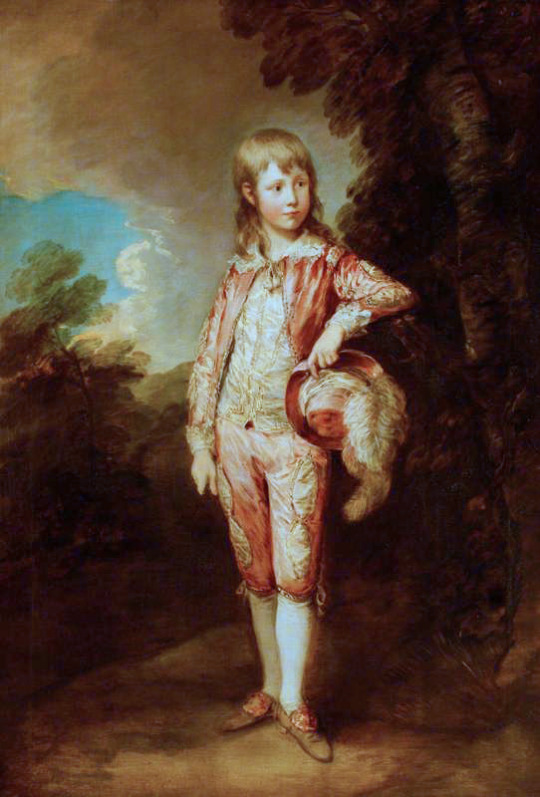
[Left: The Blue Boy, oil on canvas, c. 1770, by Thomas Gainsborough.
Right: The Pink Boy, oil on canvas, c. 1782, by Thomas Gainsborough.]
Pink is for girls and blue is for boys. But it hasn't always been this way. Colour coding infants as a way of denoting gender was popular in 20th century America. The problem? Pink and blue? Which is for boys and which is for girls?
In 1927 TIME Magazine asked ten of the "leading stores that sell baby equipment" which colour was for which gender. Four stores responded pink for girls and blue for boys; Macy's (Manhattan), Franklin Simon (Manhattan), Wanamaker's (Philadelphia) and Bullock's (Los Angeles). Five stores responded pink for boys and blue for girls; Best's (Manhattan), Marshall Field's (Chicago), Filene's (Boston), Maison Blanche (New Orleans) and The White House (San Francisco). Curiously Halle's (Cleveland) responded that pink was for both boys and girls.
This debate would continue and it wasn't until mid-20th century that pink for girls and blue for boys became firmly cemented in western culture.
However the idea of colour coding infants dates back to the 19th century. According to La cour de Hollande sous le règne de Louis Bonaparte in 1808 in Holland pink was used to announce the birth of a girl and blue a boy. In March 1856 Peterson's Magazine (Philadelphia, USA) advises that the ribbon on a christening cap should be blue for a boy and pink for a girl. On the 23rd of July 1893 the New York Times writes that for baby clothes it's "pink for a boy and blue for a girl!"

[The Oddie Children, oil on canvas, c. 1789, by William Beechey, via North Carolina Museum of Art.]
During the latter half of the 18th century one of the most popular outfits for young children, regardless of gender, was a white dress with a coloured sash tied around the waist. Pink and blue being the most popular colours, although other colours were worn as well. It would be tempting to assume that the colour of the sash indicated gender but there isn't clear evidence that this was the case. The Oddie Children (above) depicts Sarah, Henry, Catherine, and Jane Oddie. The three girls are all wearing white dresses; two with a blue sash one with a pink sash. We also see Henry Russell (bellow left) wearing a blue sash and Prince William (bellow right) wearing a pink sash.
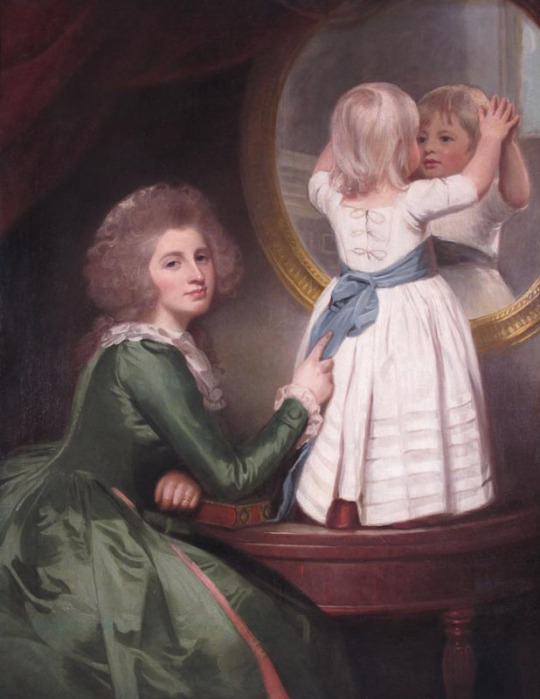
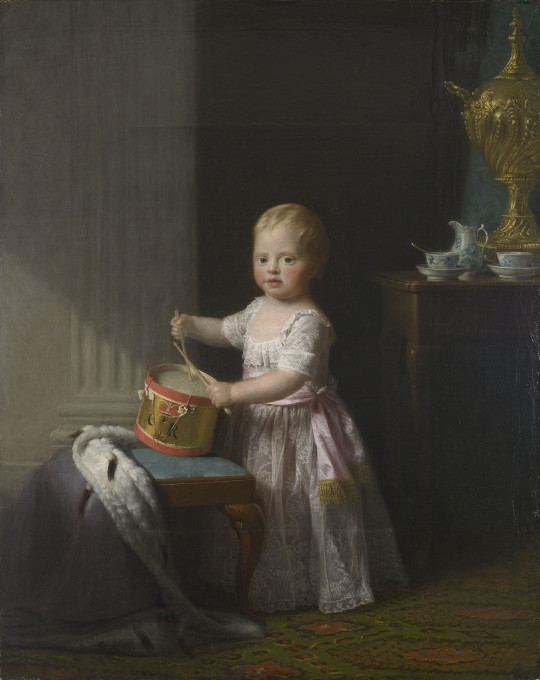
[Left: Anne Barbara Russell née Whitworth with her son Sir Henry Russell, oil on canvas, c. 1786, by George Romney, via Woolley & Wallis.
Right: Prince William, oil on canvas, c. 1767, by Allan Ramsay, via the Royal Collection Trust.]
Pink was just one of the many colours popular in 18th century English womenswear and seems to have stayed popular throughout the century. On the 3rd of January 1712 The Spectator published an article in which a man recalls seeing "a little Cluster of Women sitting together in the prettiest coloured Hoods that I ever saw. One of them was Blew, another Yellow, and another Philomot; the fourth was of a Pink Colour, and the fifth of a pale Green". On the 1st of May 1736 the Read's Weekly Journal, or British Gazetteer reports that the ladies attending the royal wedding wore gowns of "Gold stuffs, or rich Silks with Gold or Silver Flowers, or Pink or White Silks, with either Gold or Silver Netts or Trimmings;" shoes either "Pink, White or Green Silk, with Gold or Silver Lace and braid all over." On the 24th of May 1785 Charles Storer writes to Abigail Adams advising that fashionable colours in English court dress are "pink, lilac, and blue" such "as is worn at Versailles".
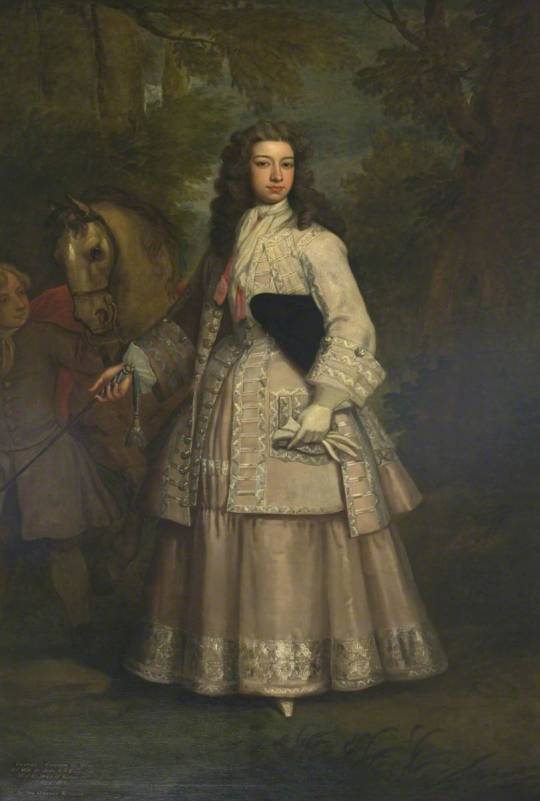
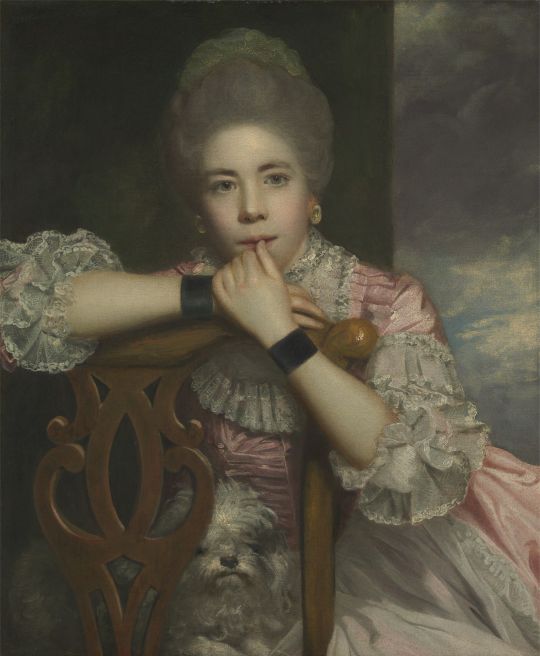
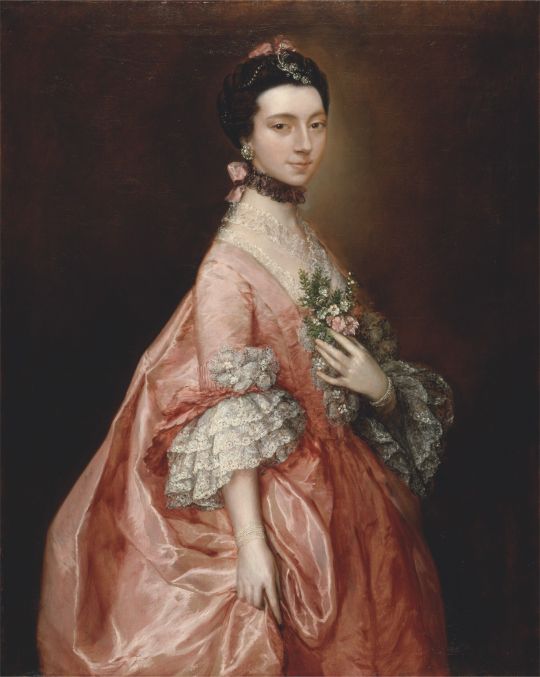
[Left: Frances, Daughter of Evelyn Pierpont, 1st Duke of Kingston, oil on canvas, c. 1700-23, by Godfrey Kneller, via Art UK.
Middle: Mrs. Abington as Miss Prue in "Love for Love" by William Congreve, oil on canvas, c. 1771, by Sir Joshua Reynolds, via Yale Center for British Art.
Right: Mary Little, later Lady Carr, oil on canvas, c. 1765, by Thomas Gainsborough, via Yale Center for British Art.]
In particular pink was popular amongst young women as the colour was associated with youth. Older women who wore pink were mocked as vain for dressing in a way that was seen as improper for their age. On the 31st of January 1754 Lady Jane Coke writes to Mrs. Eyre criticising old women who wear pink:
As for fashions in dress, which you sometimes inquire after, they are too various to describe. One thing is new, which is, there is not such a thing as a decent old woman left, everybody curls their hair, shews their neck, and wears pink, but your humble servant. People who have covered their heads for forty years now leave off their caps and think it becomes them, in short we try to out-do our patterns, the French, in every ridiculous vanity.
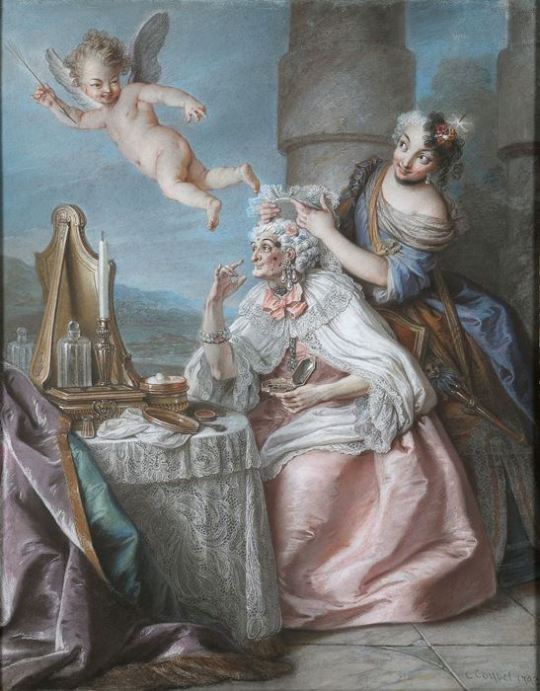
[Folly Embellishing Old Age With the Adornments of Youth, oil on canvas, c. 1743, by Charles-Antoine Coypel, via Master Art.]
For Englishmen acceptable clothing way much more limited. In A Foreign View of England in the Reigns of George I & George II Monsieur César de Saussure writes that Englishmen "do not trouble themselves about dress, but leave that to their womenfolk". He explains:
Englishmen are usually very plainly dressed, they scarcely ever wear gold on their clothes; they wear little coats called "frocks," without facings and without pleats, with a short cape above. Almost all wear small, round wigs, plain hats, and carry canes in their hands, but no swords. Their cloth and linen are of the best and finest. You will see rich merchants and gentlemen thus dressed, and sometimes even noblemen of high rank, especially in the morning, walking through the filthy and muddy streets.
César de Saussure warns that "a well-dressed person in the streets, especially if he is wearing a braided coat, a plume in his hat, or his hair tied in a bow, he will, without doubt, be called "French dog" twenty times perhaps before he reaches his destination" and is not only at risk of "being jeered at" but also "being bespattered with mud, but as likely as not dead dogs and cats will be thrown at him."
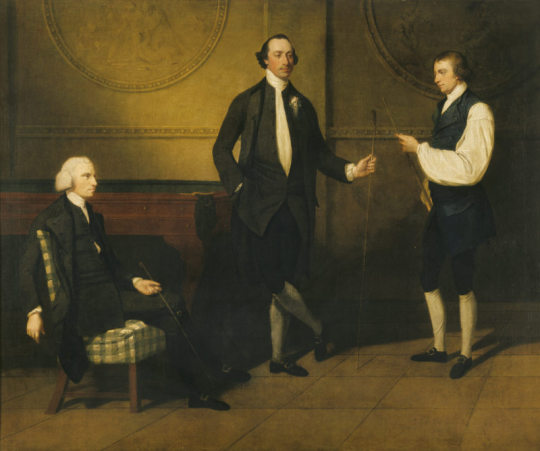
[Reverend Charles Everard Booth, Captain Griffith Booth, and an Unidentified Man playing Billiards, oil on canvas, c. 1775-9, by John Hamilton Mortimer, via the Royal Collection Trust.]
For Englishmen dressing "plainly" mostly meant wearing blacks and browns. In his book on macaroni, Pretty Gentleman, Peter McNeil found that in contrast most English menswear that he describes as generally consisting of "monochrome broadcloth" macaroni wore a variety of colours including green, orange, yellow, violet, red, white, blue, gold, silver and of course pink.
But it's not just the macaroni of the 1770s & 1780s that wore pink. We see pink in descriptions of feminine men's dress (both real and fictional) throughout the 18th century.
On the 2nd of June 1722 Sarah Osborn writes to Robert Byng:
I believe the gentlemen will wear petticoats very soon, for many of their coats were like our mantuas. Lord Essex had a silver tissue coat, and pink color lutestring waistcoat, and several had pink color and pale blue paduasoy coats, which looked prodigiously effeminate.
On the 18th of October 1729 the Universal Spectator and Weekly Journal published a story where an "effeminate" man's clothes were described as follows:
He had a flower'd pink-colour Silk Coat, with a Green-Sattin Waistcoat lac'd with Silver. Velvet Breeches, Clock'd Stockings the Colour of his Coat, Red-heel'd Pumps, a Blue Ribbon at the Collar of his Shirt, and his Sword-Hilt he embrac'd under the Elbow of his Left Arm,

[Sir Miles Stapylton, 4th Bt of Myton, oil on canvas, c. 1730-35, via Art UK.]
In The Adventures of Roderick Random (1748) the effeminate (and queer coded) Captain Whiffle is described as follows:
our new commander came on board in a ten-oared barge, overshadowed with a vast umbrella, and appeared in everything the reverse of Oakum, being a tall, thin young man, dressed in this manner: a white hat, garnished with a red feather, adorned his head, from whence his hair flowed upon his shoulders, in ringlets tied behind with a ribbon. His coat, consisting of pink-coloured silk, lined with white, by the elegance of the cut retired backward, as it were, to discover a white satin waistcoat embroidered with gold, unbuttoned at the upper part to display a brooch set with garnets, that glittered in the breast of his shirt, which was of the finest cambric, edged with right Mechlin: the knees of his crimson velvet breeches scarce descended so low as to meet his silk stockings, which rose without spot or wrinkle on his meagre legs, from shoes of blue Meroquin, studded with diamond buckles that flamed forth rivals to the sun! A steel-hilted sword, inlaid with gold, and decked with a knot of ribbon which fell down in a rich tassel, equipped his side; and an amber-headed cane hung dangling from his wrist. But the most remarkable parts of his furniture were, a mask on his face, and white gloves on his hands, which did not seem to be put on with an intention to be pulled off occasionally, but were fixed with a curious ring on the little finger of each hand.

[Henry Ingram, 7th Viscount Irwin and His Wife Anne, oil on canvas, c. 1745, by Philippe Mercier, via Art UK.]
On the 28th of July 1780 the London Courant reports:
A few days ago, a Macaroni made his appearance in the Assembly-room at Whitehaven, in the Following dress: a mixed silk coat, pink sattin waistcoat and breeches, covered with an elegant silver nett, white silk stockings with pink clocks, pink sattin shoes and large pearl buckles, a mushroom coloured stock, covered with a fine point lace; his hair dressed remarkably high, and stuck full of pearl pins.
On the 6th of August 1792 The Weekly Entertainer published Sketches and Portraits form the Life by Simon Tueopnrastus which included the following description:
Mercator was a youth of some genius and expectation, but by a strange perverseness of disposition, notwithstanding the extreme natural stiffness of his limbs, he had acquired an early attachment to the most finical and effeminate finery; so that, while yet a boy, he would exhaust every expedient of a fertile invention to procure a laced waistcoat, or the most foppish toy; would dangle a watch-string, with brass seals, from each fob, at a time when the frugal care of his parents would not permit him to wear a watch in either; and would strut in a fine pair of second-hand pink silk breeches, and a light blue coat, with all the formal dignity of—a soldier upon the parade.


[Left: Thomas King in "The Clandestine Marriage", oil on canvas, c. 1792, by Samuel De Wilde, via Yale Center for British Art.
Right: Edward Payne, oil on canvas, by Arthur Devis, via Art UK.]
While pink is mentioned in these descriptions of feminine men's dress it's not singled out as the girl colour the way pink would become in the 20th century. I would argue pink is seen as effeminate not because pink is a uniquely feminine colour but because it was used in fashionable dress. In 18th century England being interested in fashion was seen as an frivolous female trait. Men who showed too much interest in fashion were mocked and ridiculed for their gender nonconformity. "A Man must sink below the Dignity of his Nature, before he can suffer his Thoughts to be taken up on so trivial an Affair, as the Chosing, Suiting, and Adjusting the Adornments of his Person," complains a letter published on the 8th of May 1731 in Read's Weekly Journal, or British Gazetteer:
Decency of Garb ought inviolably to be preserved; nor can there be possibly an Excuse for Dressing like a Merry-Andrew: Rich and coloured Silks are in themselves effeminate, and unbecoming a Man; as are, in short, all Things that discover Dress to have been his Study 'Tis in vain for a Fop of Quality, to think his Title will protect him.


[Left: Madame de Pompadour (detail), oil on canvas, c. 1756, by François Boucher, via Alte Pinakothek.
Right: Elizabeth Wrottesley, later Duchess of Grafton, oil on canvas, c. 1764-5, by Thomas Gainsborough, via National Gallery of Victoria.]
English fashion was highly influenced by French fashion. A popular colour scheme in French fashion was green and pink. A famous example of this colour pairing can be seen in François Boucher's portrait of Madame de Pompadour (above left), she is depicted in a green gown with pink bows and flowers. You can see and example of how this style inspired English fashion in Thomas Gainsborough's portrait of Elizabeth Wrottesley (above right), who is depicted in a green gown with a floral pattern adorned with pink, white and green striped bows.
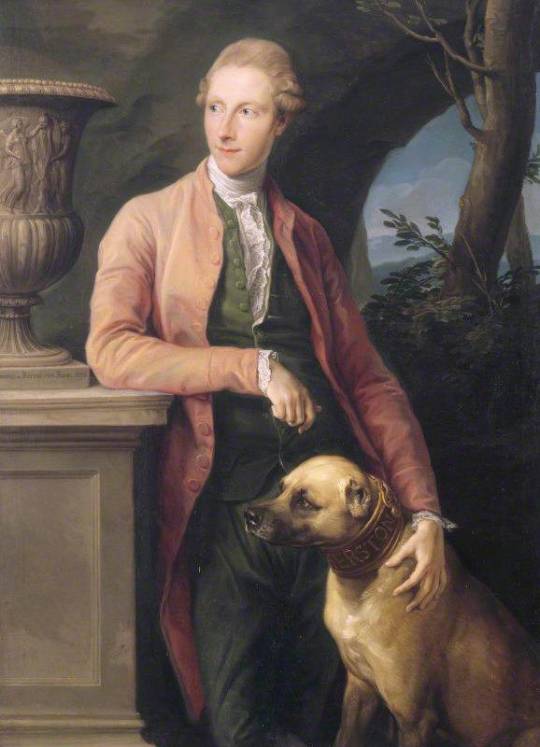
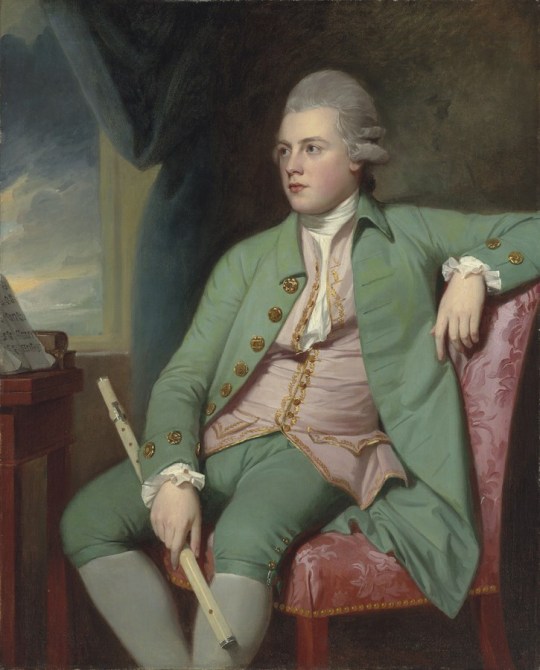
[Left: Sir Harry Fetherstonhaugh, oil on canvas, c. 1776, by Pompeo Batoni, via Wikimedia.
Right: Francis Lind, oil on canvas, c. 1775, by George Romney, via Mackinnon Fine Art.]
Fashionable Englishmen were also inspired by these French designs. Horace Walpole refers to the popularity of the colour combination writing to Lady Ossory on the 19th of February 1774 "If I went to Almack's and decked out my wrinkles in pink and green like Lord Harrington, I might still be in vogue". Almack's is referring to Almack's Assembly Rooms on Pall Mall which is believed to be the inspiration for the Macaroni Club. (see Pretty Gentleman by Petter McNeil p52-55) In a letter to Lord Harcourt on the 27th of July 1773 Walpole writes of "Macaronis lolling out of windows at Almack's like carpets to be dusted."
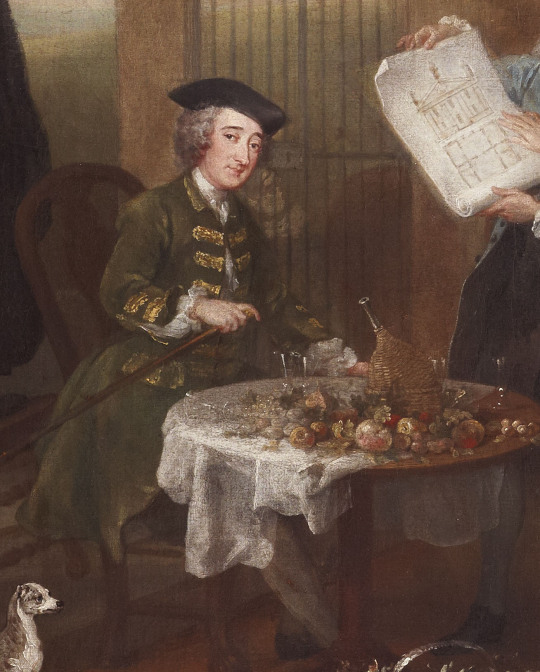

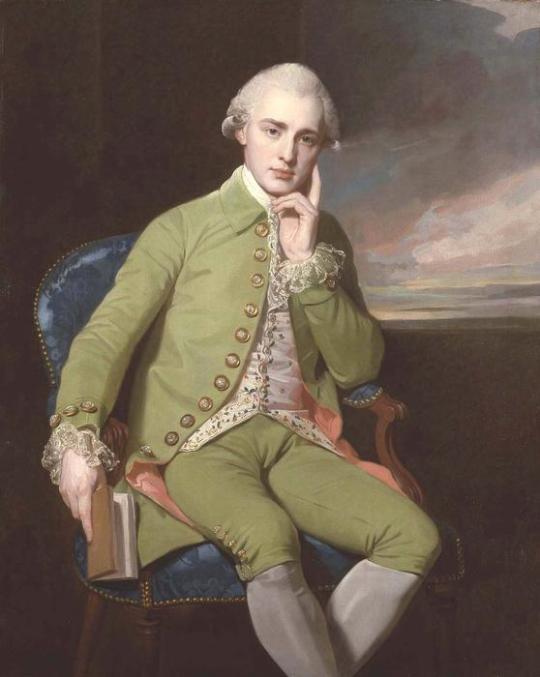
[Left: Detail of Stephen Fox from The Hervey Conversation Piece, oil on canvas, c. 1738-40, by William Hogarth, via Fairfax House.
Middle: Sir William Jones, oil on canvas, c. 1769, by Francis Cotes, via Art UK.
Right: Portrait of a Gentleman, oil on canvas, by George Romney.]
Men who wore green seem to have been just as much, if not more, at risk of being ridiculed, or even assaulted, for the colour of their clothes as those who wore pink. In Pierre Jean Grosley's A Tour to London (originally published 1772) he recalls traveling with a young English surgeon who was harassed by Londoners due to his green French frock coat:
At the first visit which he paid me in London, he informed me, that, a few days after his arrival, happening to take a walk thro' the fields on the Surry side of the Thames, dressed in a little green frock, which he had brought from Paris, he was attacked by three of those gentlemen of the mobility, who, taking him for a Frenchman, not only abused him with the foulest language, but gave him two or three slaps on the face: "Luckily, added he in French, I did not return their ill language; for, if I had, they would certainly have thrown me into the Thames, as they assured me they would, as soon as they perceived I was an Englishman, if I ever happened to come in their way again, in my Paris dress."
244 notes
·
View notes
Text



















Historical Portraits of Children // The Truth is a Cave – The Oh Hellos
Four Children Making Music – attributed to the master of the Countess of Warwick, 1565 // Three Children with a Dog or Two Sisters and a Brother of the Artist – Sofonisba Anguissola, 1570-1590 // The Children of Philip III of Spain (Ferdinand, Alfonso, and Margarita) – Bartolomé González y Serrano, 1612 // Three Children with a Goat-Cart – Frans Hals, 1620 // The Balbi Children – Anthony van Dyck, 1625-1627 // The Three Eldest Children of Charles I – Anthony van Dyck, 1635-1636 // Five Eldest Children of Charles I – Anthony van Dyck, 1637 // Portrait of the Children of Habert de Montmor – Philippe de Champaigne, 1649 // Group Portrait of Charlotte Eleonora zu Dohna, Amalia Louisa zu Dohna, and Friedrich Christoph zu Dohna-Carwinden – Pieter Nason, 1667 // The Graham Children – William Hogarth, 1742 // Portrait of Sir Edward Walpole’s Children – Stephen Slaughter, 1747 // The Bateson Children – Strickland Lowry, 1762 // The Gower Family: The Five Youngest Children of the 2nd Earl Gower – George Romney, 1776-1777 // Marie-Antoinette de Lorraine-Habsbourg, Queen of France, and Her Children – Élisabeth Louise Vigée Le Brun, 1787 // The Marsham Children – Thomas Gainsborough, 1787 // The Oddie Children – William Beechey, 1789 // Three Siblings – Johann Nepomuk Mayer, 1846 // Happy Children – Paul Barthel, 1898 // My Children – Joaquín Sorolla, 1904 // The Truth is a Cave – The Oh Hellos
#this line makes me feel Very Normal and not at all Deranged 🥴😵💫#portraiture#family portrait#portrait#portrait painting#sofonisba anguissola#frans hals#anthony van dyck#philippe de champaigne#william hogarth#george romney#elisabeth vigee le brun#elisabeth louise vigee le brun#thomas gainsborough#joaquin sorolla#the truth is a cave#the truth is a cave song#the truth is a cave the oh hellos#through the deep dark valley#through the deep dark valley album#through the deep dark valley the oh hellos#the oh hellos#art history#art#lyrics#lyric art#long post
100 notes
·
View notes
Text
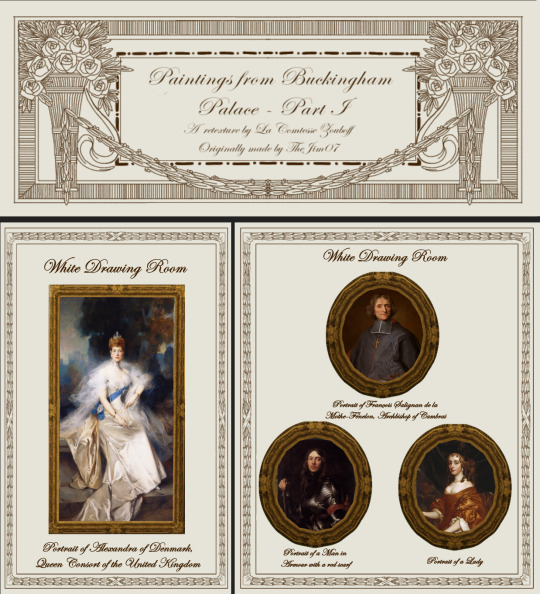
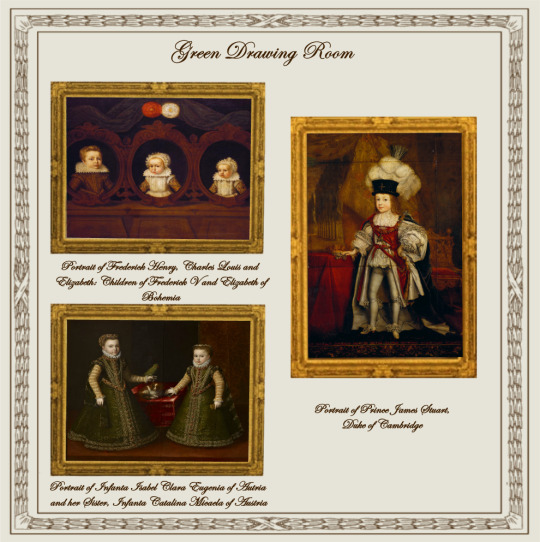
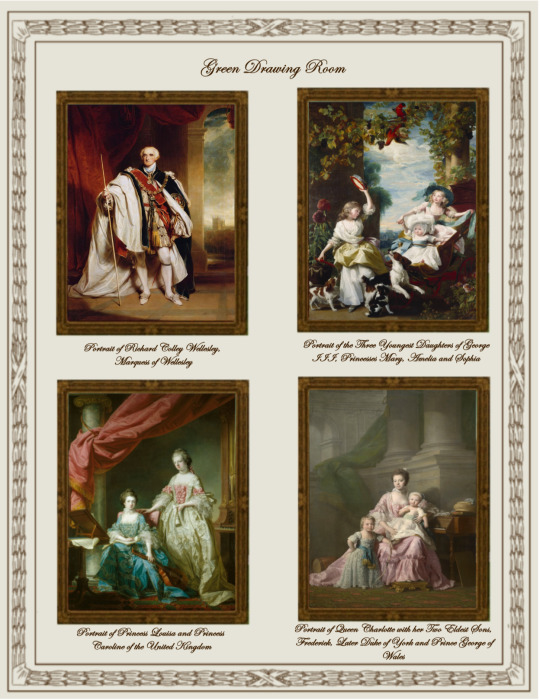
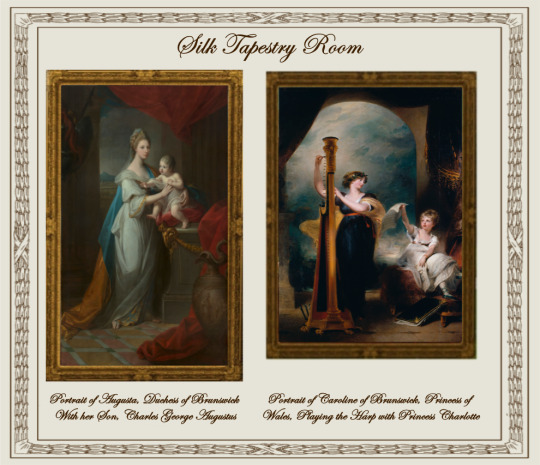
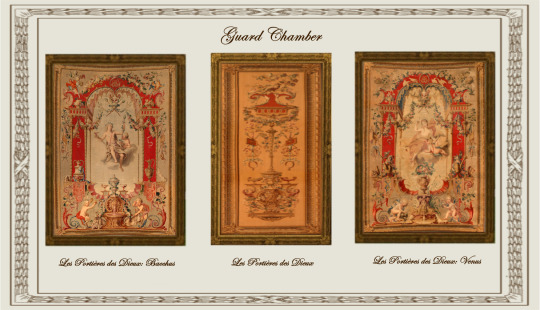
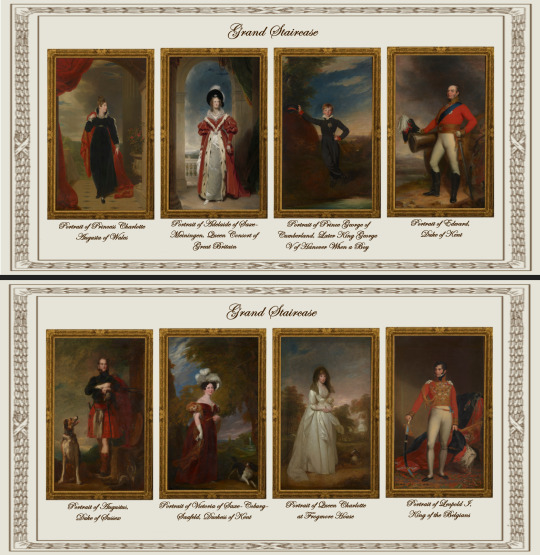
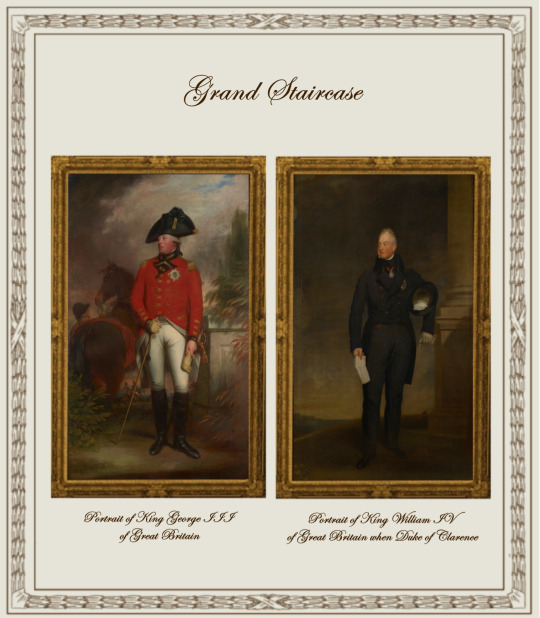
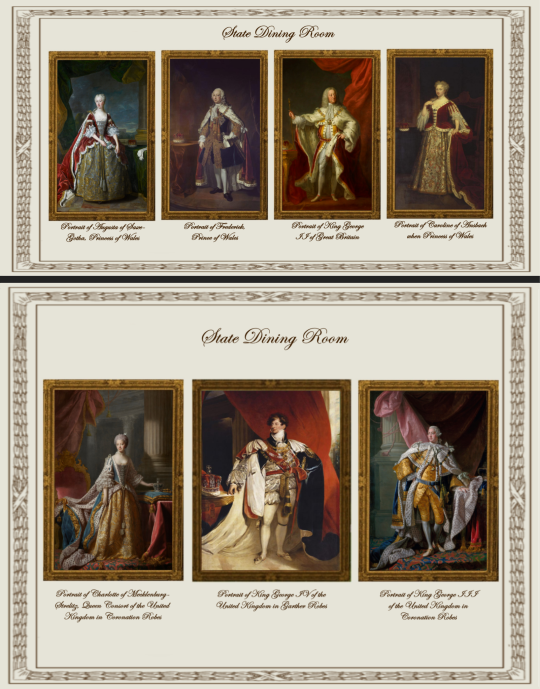
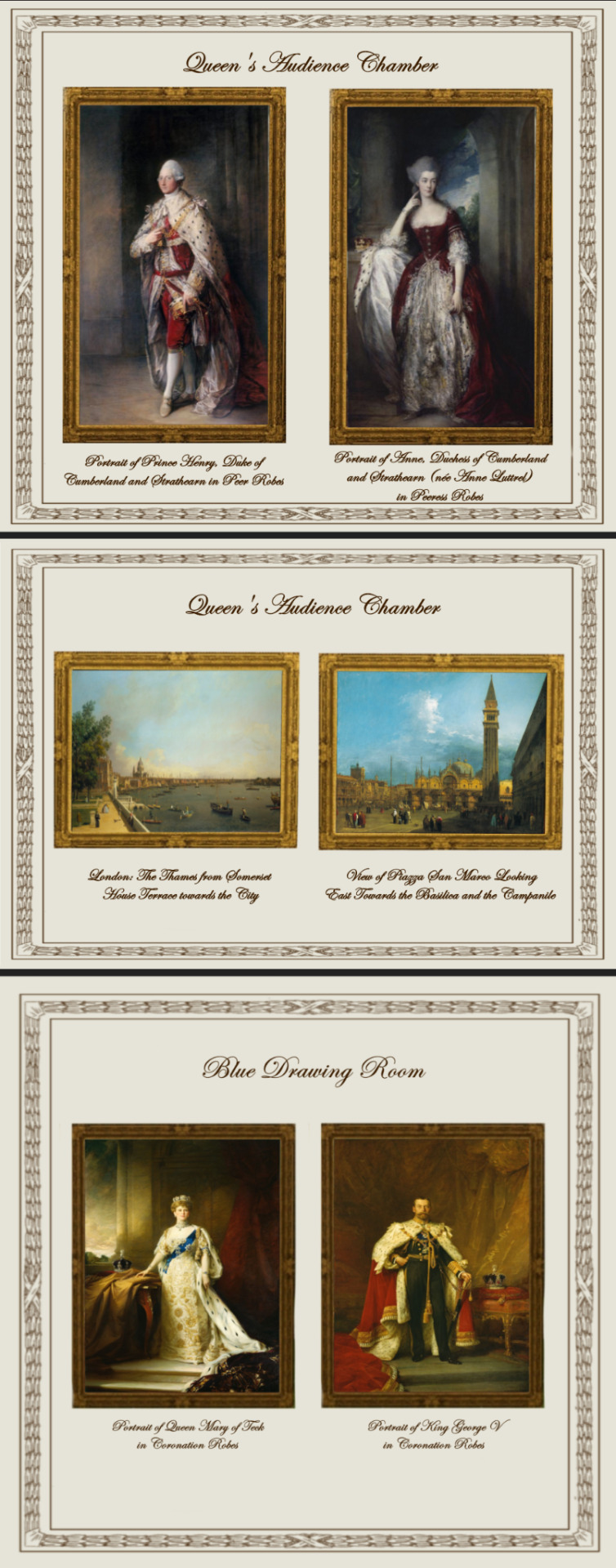
Paintings from Buckingham Palace: part I
A retexture by La Comtesse Zouboff — Original Mesh by @thejim07
100 followers gift!
First of all, I would like to thank you all for this amazing year! It's been a pleasure meeting you all and I'm beyond thankful for your support.
Spread among 13 occupied and historic royal residences in the United Kingdom, the collection is owned by King Charles III and overseen by the Royal Collection Trust. The British monarch owns some of the collection in right of the Crown and some as a private individual. It is made up of over one million objects, including 7,000 paintings, over 150,000 works on paper, this including 30,000 watercolours and drawings, and about 450,000 photographs, as well as around 700,000 works of art, including tapestries, furniture, ceramics, textiles, carriages, weapons, armour, jewellery, clocks, musical instruments, tableware, plants, manuscripts, books, and sculptures.
Some of the buildings which house the collection, such as Hampton Court Palace, are open to the public and not lived in by the Royal Family, whilst others, such as Windsor Castle, Kensington Palace and the most remarkable of them, Buckingham Palace are both residences and open to the public.
About 3,000 objects are on loan to museums throughout the world, and many others are lent on a temporary basis to exhibitions.
-------------------------------------------------------
This first part includes the paintings displayed in the White Drawing Room, the Green Drawing Room, the Silk Tapestry Room, the Guard Chamber, the Grand Staircase, the State Dining Room, the Queen's Audience Room and the Blue Drawing Room,
This set contains 37 paintings and tapestries with the original frame swatches, fully recolourable. They are:
White Drawing Room (WDR):
Portrait of François Salignan de la Mothe-Fénelon, Archbishop of Cambrai (Joseph Vivien)
Portrait of a Lady (Sir Peter Lely)
Portrait of a Man in Armour with a red scarf (Anthony van Dyck)
Portrait of Alexandra of Denmark, Queen Consort of the United Kingdom and Empress of India (François Flameng)
Green Drawing Room (GDR):
Portrait of Prince James Stuart, Duke of Cambridge (John Michael Wright)
Portrait of Frederick Henry, Charles Louis and Elizabeth: Children of Frederick V and Elizabeth of Bohemia (unknown)
Portrait of Infanta Isabel Clara Eugenia of Autria and her Sister, Infanta Catalina Micaela of Austria (Alonso Sanchez Coello)
Portrait of Princess Louisa and Princess Caroline of the United Kingdom (Francis Cotes)
Portrait of Queen Charlotte with her Two Eldest Sons, Frederick, Later Duke of York and Prince George of Wales (Allan Ramsay)
Portrait of Richard Colley Wellesley, Marquess of Wellesley (Martin Archer Shee)
Portrait of the Three Youngest Daughters of George III, Princesses Mary, Amelia and Sophia (John Singleton Copley)
Silk Tapestry Room (STR):
Portrait of Caroline of Brunswick, Princess of Wales, Playing the Harp with Princess Charlotte (Sir Thomas Lawrence)
Portrait of Augusta, Duchess of Brunswick With her Son, Charles George Augustus (Angelica Kauffmann)
Guard Chamber (GC):
Les Portières des Dieux: Bacchus (Manufacture Royale des Gobelins)
Les Portières des Dieux: Venus (Manufacture Royale des Gobelins)
Les Portières des Dieux (Manufacture Royale des Gobelins)
Grand Staircarse (GS):
Portrait of Adelaide of Saxe-Meiningen, Queen Consort of Great Britain (Martin Archer Shee)
Portrait of Augustus, Duke of Sussex (Sir David Wilkie)
Portrait of Edward, Duke of Kent (George Dawe)
Portrait of King George III of Great Britain (Sir William Beechey)
Portrait of King William IV of Great Britain when Duke of Clarence (Sir Thomas Lawrence)
Portrait of Leopold I, King of the Belgians (William Corden the Younger)
Portrait of Prince George of Cumberland, Later King George V of Hanover When a Boy (Sir Thomas Lawrence)
Portrait of Princess Charlotte Augusta of Wales (George Dawe)
Portrait of Queen Charlotte at Frogmore House (Sir William Beechey)
Portrait of Victoria of Saxe-Coburg-Saafeld, Duchess of Kent (Sir George Hayter)
State Dining Room (SDR):
Portrait of Charlotte of Mecklenburg-Strelitz, Queen Consort of the United Kingdom in Coronation Robes (Allan Ramsay)
Portrait of King George III of the United Kingdom in Coronation Robes (Allan Ramsay)
Portrait of Augusta of Saxe-Gotha, Princess of Wales (Jean-Baptiste Van Loo)
Portrait of Caroline of Ansbach when Princess of Wales (Sir Godfrey Kneller)
Portrait of Frederick, Princes of Wales (Jean-Baptiste Van Loo)
Portrait of King George II of Great Britain (John Shackleton)
Portrait of King George IV of the United Kingdom in Garther Robes (Sir Thomas Lawrence)
Queen's Audience Room (QAR):
Portrait of Anne, Duchess of Cumberland and Strathearn (née Anne Luttrel) in Peeress Robes (Sir Thomas Gainsborough)
Portrait of Prince Henry, Duke of Cumberland and Strathearn in Peer Robes (Sir Thomas Gainsborough)
London: The Thames from Somerset House Terrace towards the City (Giovanni Antonio Canal "Canaletto")
View of Piazza San Marco Looking East Towards the Basilica and the Campanile (Giovanni Antonio Canal "Canaletto")
Blue Drawing Room (BDR)
Portrait of King George V in Coronation Robes (Sir Samuel Luke Fildes)
Portrait of Queen Mary of Teck in Coronation Robes (Sir William Samuel Henry Llewellyn)
-------------------------------------------------------
Found under decor > paintings for:
500§ (WDR: 1,2 & 3)
1850§ (GDR: 1)
1960§ (GDR: 2 & 3 |QAR 3 & 4)
3040§ (STR, 1 |GC: 1 & 2|SDR: 1 & 2)
3050§ (GC:1 |GS: all 10|WDR: 4 |SDR: 3,4,5 & 6)
3560§ (QAR: 1 & 2|STR: 2)
3900§ (SDR: 7| BDR: 1 & 2|GDR: 4,5,6 & 7)
Retextured from:
"Saint Mary Magdalene" (WDR: 1,2 & 3) found here .
"The virgin of the Rosary" (GDR: 1) found here .
"The Four Cardinal Virtues" (GDR: 2&3|QAR 3 & 4) found here.
"Mariana of Austria in Prayer" (STR, 1, GC: 1 & 2|SDR: 1 & 2) found here.
"Portrait of Philip IV with a lion at his feet" (GC:1 |GS: all 10|WDR: 4 |SDR: 3,4,5 & 6) found here
"Length Portrait of Mrs.D" (QAR: 1 & 2|STR: 2) found here
"Portrait of Maria Theresa of Austria and her Son, le Grand Dauphin" (SDR: 7| BDR: 1 & 2|GDR: 4,5,6 & 7) found here
(you can just search for "Buckingham Palace" using the catalog search mod to find the entire set much easier!)
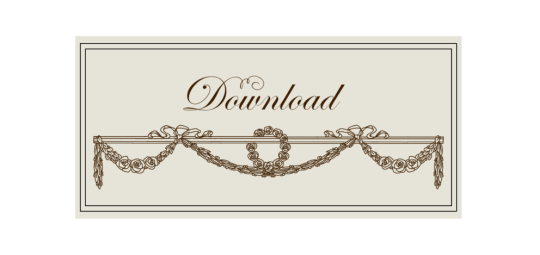
Drive
(Sims3pack | Package)
(Useful tags below)
@joojconverts @ts3history @ts3historicalccfinds @deniisu-sims @katsujiiccfinds @gifappels-stuff
-------------------------------------------------------
#the sims 3#ts3#s3cc#sims 3#sims 3 cc#sims 3 download#sims 3 decor#edwardian#rococo#baroque#renaissance#buckingham#buckingham palace#royal collection trust#wall decor
131 notes
·
View notes
Text

Sir William Beechey RA (British, 1753-1839) Victoria, Duchess of Kent (1786-1861) with Princess Victoria, ca.1824 Royal Collection Trust
#William Beechey#victoria duchess of kent#princess victoria#1824#1800s#british art#british#britain#art#fine art#european art#classical art#europe#european#fine arts#oil painting#europa#real people#brunette#blonde#brown eyes#black eyes
34 notes
·
View notes
Text
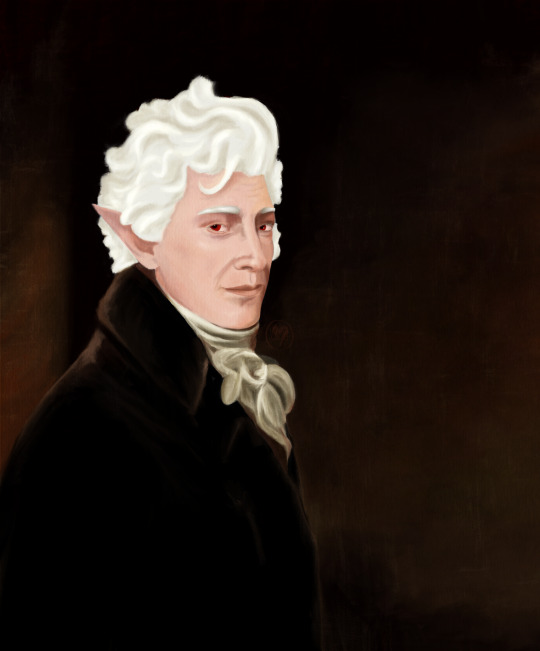
Astarion portrait style study, based on Self Portrait by Sir William Beechey, c.1800
#he was so tricky to paint in this style#i spent 14 hours on this and easily could have spent 14 more#but it’s a study & I’ve got to stop at some point#astarion ancunin#bg3#baldur's gate 3#regency era#regency au#astarion#self portrait william beechey#my art#art study#portrait study#style study#art studies#meg does art
17 notes
·
View notes
Text
ok its after 8pm time for my nightly gladman point skeleton posting power hour. welcome to speculation city
june 1845 - sept 1845, henry making idle notes about how the expedition's going because well. yes. of course

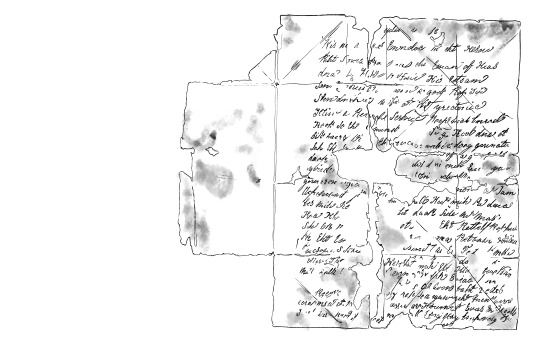
1846 - henry gets really into bullet journaling in the first winter wherein the ships are docked in devon harbor/beechey island. also it's cold as fuck and he's starting to realize it's gonna be cold as fuck for a long while yet, and after recently rekindling a relationship Of Some Kind with tom armitage, he starts getting nostalgic about partying in venezuela when he was 23 which is funny because on one hand we have very hard ground to heave on the morrow (gravedigging, hauling to the cairn, etc) but also omgggg do you remember stuart the shipcat he was the best. that party ruled does anyone else remember how fun that nye party was!!!


april 1847 - after months of teaching his good friend tom armitage his letters (finally), tom manages to get a parody flirty smutty version of barry cornwall's 'the sea' written down after henry had recited it aloud from memory and henry is so proud about how quickly tom's taken to writing after 40 something years of adamantly refusing to learn, that he keeps the page in his wallet
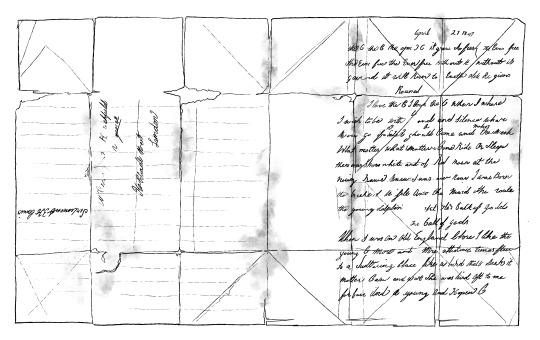

june 1847 - sir john dies and henry decides to take some asides about the funeral speech, presumably under the impression that they'd get home again at some point and he could decipher it and make it presentable later. officers do seem to be dropping quite quickly though and the inclination that things might not be working out excellently starts around here.

july thru dec 1847 - the terror camp in cape felix is established and henry overhears calls that camp is clear over and over and over enough times that he thinks its worth writing down while doing his silly spiral doodles to pass the time in the evenings

spring 1848 - the crews abandon the ships for real this time and the fear that he's not getting out of the arctic alive starts to feel more and more real each day, and in a vague attempt to keep himself from being lost and forgotten to history, he writes down a frantic account of his navy career in his cleanest neatest most legible handwriting possible. for future searchers to be able to read. also, messages get passed between erebus camp and terror camp and the men are inventing fake addresses for the letters between camps for...... whimsy? missing london society? i dont know

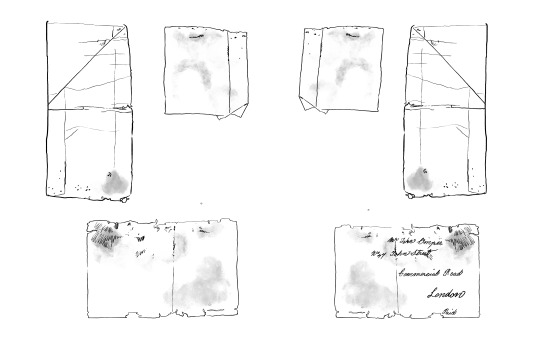
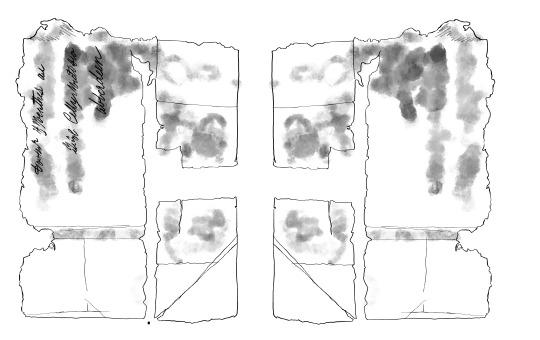

end of 1848 - the Unwellnesses and the Agonies are really settling in amongst the whole crew but hey. at least he still has the brain power for poems written backwards.

early 1849 - powering thru this dismal ass expedition's survival attempts based on absolutely nothing but the desperate nostalgia of being young and sexy and warm. thank goodness tom armitage is still here to help him remember specific details about the clubs in the caribbean. and we are simply too tired to continue the backwards code, but no one's pawing through his personals anyways, it hardly matters


mid to late 1849 - henry dies from [REDACTED] and tom armitage takes it upon himself to carry henry's wallet and pages forward south with the expedition because it would be impossible to carry his actual physical corpse with them because everyone else, himself included, are too weak and sick for such a thing. theyve been leaving their dead behind since they were at beechey, what makes henry's remains so special and different? the survivors keep heading south along the coastline of king william island
spring 1850 - the expedition, lead by aglooka, camp briefly nearby some inuit families. they stay in one place for quite a while, and tom armitage decides they're so fucking cooked and never getting off this island. he doesn't have the supplies or means to write anything to add to the wallet, so he does his best at identifying himself by getting dressed in his steward uniform, some things that were relevant to being a steward, henry's wallet, henry's shirt with the ink stains on the cuff, and walks off to the ocean shoreline until he drops dead and falls face down with the wallet underneath his chest to keep it safe from the arctic elements

1859 - mcclintock's search party stumbles across his skeleton on accident while looking for a cairn and go WHOAAAAA ITS A SKELETON and lift the steward tools + henry's wallet out from his ribs and take them back to england to be archived

1973 - the 1st battalion rcr goes back to doublecheck mcclintock's notes and go WHOAAAAA ITS A SKELETON and lay what remains of tom out on a plywood board from a hardware store and snap some pics. then they pack him up and mail his bones to the national museum of man & then the museum loses his bones
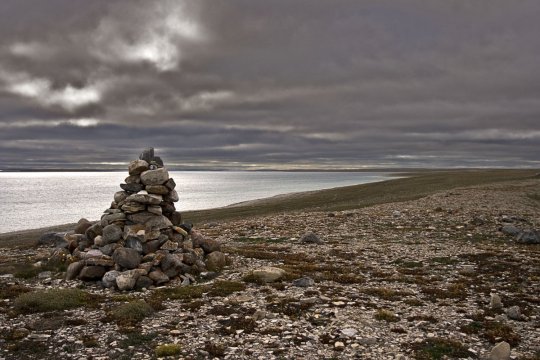



2018 - amc gives this storyline to a 26 year old from the opposite ship who had no prior history with henry for some reason and also demotes it to a sub-sub-plot. i dont know. smashing my head through a wall.
2022 - doug stenton shows up and says hey ummmm should we be more concerned about the fact that the entire fucking skeleton went missing. let me do some research i guess
2024 - i show up and start connecting the dots while working on the facsimile project of the papers. henry's fate still unknown. tom's bones still missing in action. the actual papers hidden behind an unbearably steep paywall thats gonna take me a decade to afford. facsimile project kind of overshadowed by jfj cannibalism confirmation on the same day. i keep being crazed on my blog anyways.
ok yay
19 notes
·
View notes
Photo
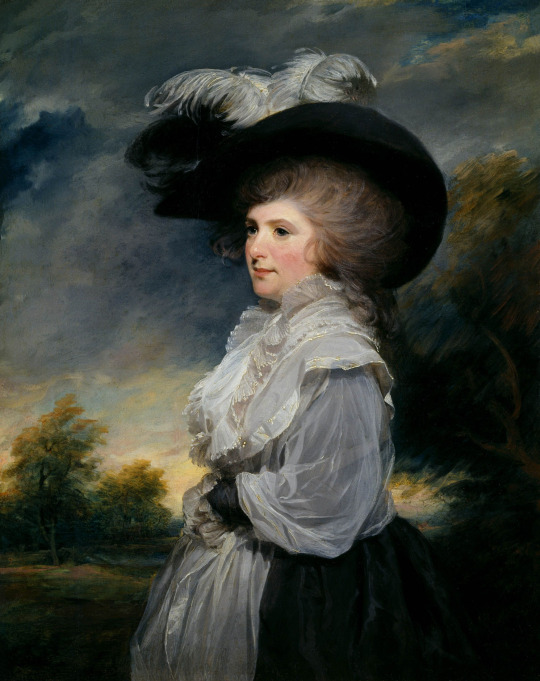
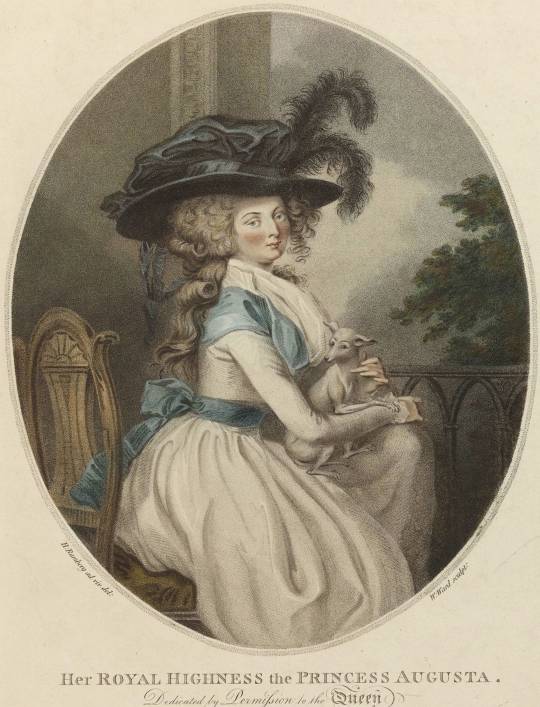
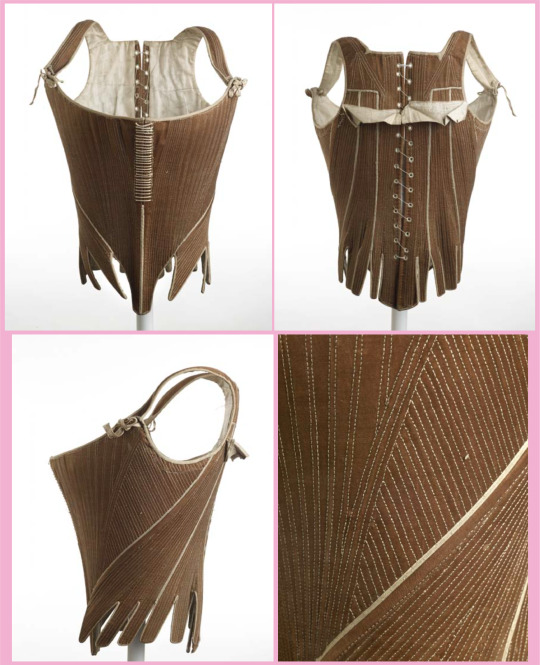
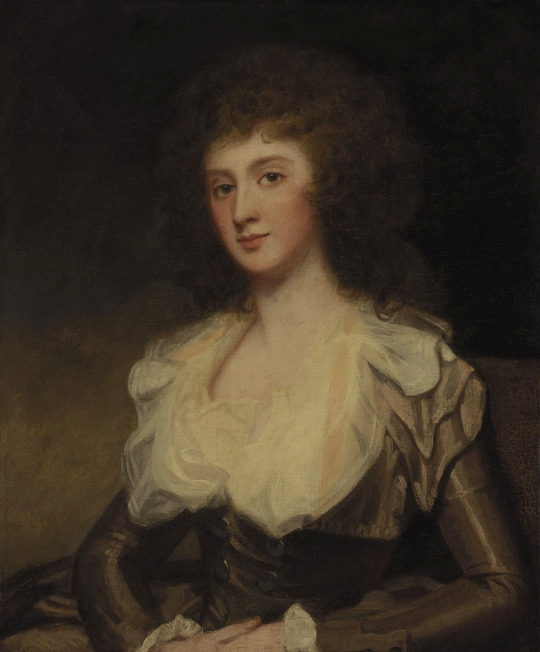
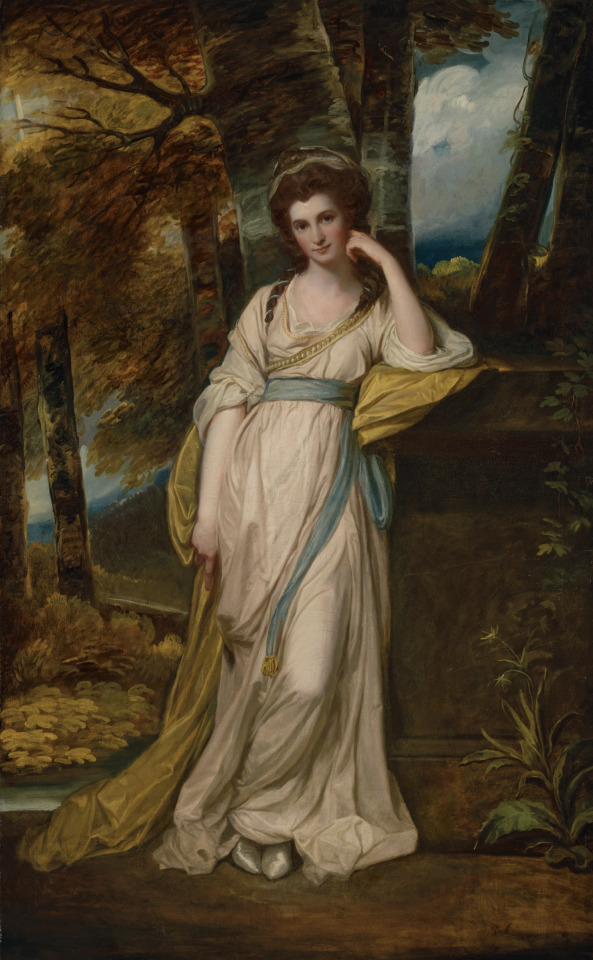
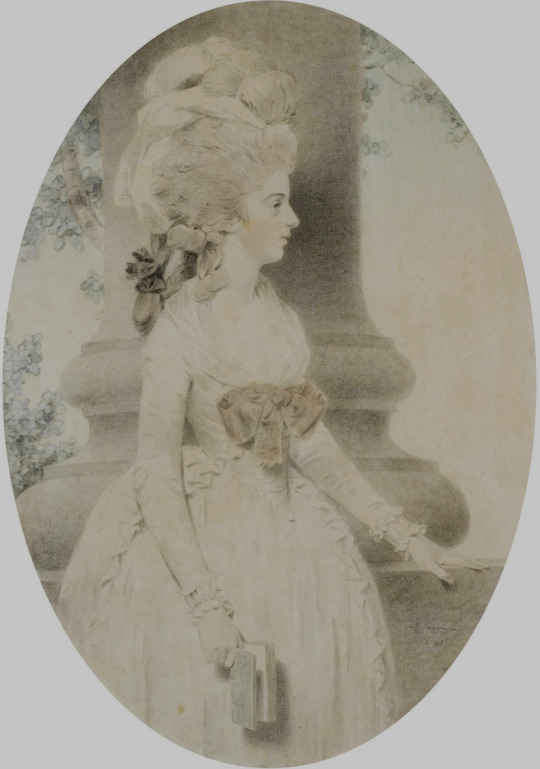
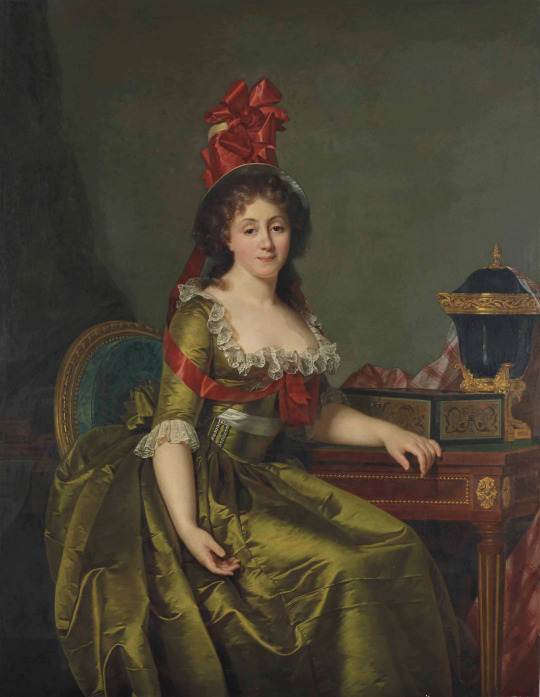
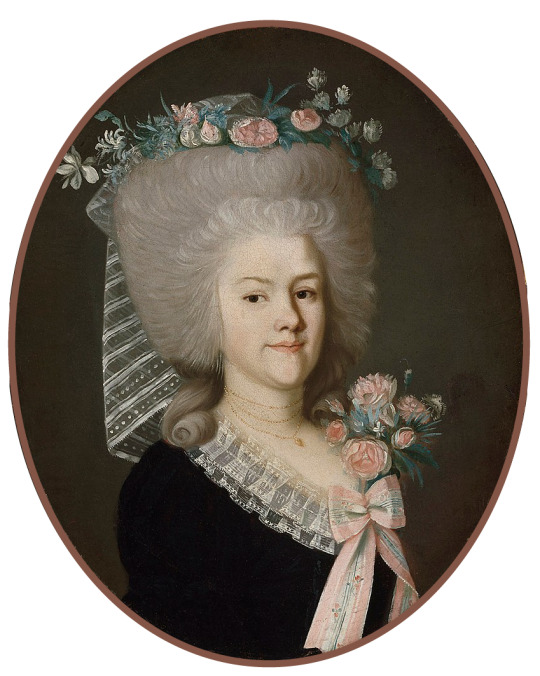
And more Big Hair (from top to bottom) -
ca. 1782-1787 Mary Constance by Sir William Beechey (Denver Art Museum - Denver, Colorado, USA). From Wikimedia; fixed spots & cracks w Pshop 2031X2560.
ca. 1788 HRH The Princess Augusta probably by William Ward after Johann Heinrich Ramberg. From pinterest.com/mama_stav/гравюры-цветные/ 7999X10466.
1780-1785 Corset of brown cotton twill with shoulder straps that tie at front with cotton (linen?) twill tape; holes down centre back for closure (Museum of London - London, UK). From their Web site 2894X3563.
Mrs. Mary Pemberton by George Romney (auctioned by Christie's). From their Web site; removed more obvious spots and cracks with Photoshop and filled in shadows 40% 1464X1767.
Mrs Deborah Jemima Maxwell (1755-1789) by George Romney (auctioned by Christie's). From their Web site 1478X2391.
1786 Miss Hodgson by John Downman (auctioned by Bonhams). From their Web site; decreased exposure and increased contrast 1629X2320.
Lady, seated, three-quarter-length, in a green satin dress and a bonnet with red ribbons by Rose-Adelaïde Ducreux (auctioned by Christie's). From their Web site; removed creases and cracks and fixed left and upper edges with Photoshop 1602X2069. This could be from the 90s.
1785-1787 Brita Elisabet Gyllenspetz by Nils Schillmark (Ateneum - Helsinki, Finland). From Wikimedia; removed flaws along top and spots throughout with Photoshop 849X1063.
#1780s fashion#Louis XVI fashion#Rococo fashion#Georgian fashion#William Beechey#picture hat#bouffant coiffure#full skirt#Princess Augusta#hat feathers#waist band#corset#Mary Pemberton#George Romney#fichu#lapels#Deborah Jemima Maxwell#close skirt#flowing skirt#shoes#Miss Hodgson#John Downman#zone bodice#bow#Rose-Adelaïde Ducreux#hat ribbons#square neckline#bertha#Nils Schillmark#floral headdress
40 notes
·
View notes
Text
Death and Post-mortem of William Braine
Welcome to another post about William Braine. In this post we're gonna talk about and look into further detail that death, post-mortem, disinterment, and autopsy of this Royal Marine and take a look at his autopsy results which may or may not give light on his cause of death. If you haven't seen my post about him about his life and you're curious as to who he was, check out the link here.
Fair Warning, I would advise to put down whatever you're eating or feel free to skip as there will be some pictures or illustrations of dead bodies in this post.

William Braine served as a Royal Marine Private in the famous Franklin Expedition, which tried to find the final piece of the Northwest Passage. He was under Sgt. David or Daniel Bryant and was one of the 14 marine detachments of the Franklin Expedition. Unfortunately, during the first wintering at Beechey Island, on January 1846, John Torrington of the HMS Terror and John Hartnell of the HMS Erebus died and were buried at the island. 3 months later, on April 3rd, William Braine followed them into the grave. He was buried in Beechey Island. What happened to his widow thereafter is unknown.
For 6 years, the graves lay undisturbed, until a search party from around 1850 discovered the graves. It is here that we get to take a first look at Braine's possibly original grave.

Braine's tombstone is on the far left with the inscription:
"Sacred
to the
Memory
of
W. Braine, R.M.
HMS Erebus
Died April 3rd, 1846
Aged 32 years
'Choose ye this day whom ye
will serve' Joshua XXIV Ver. 6"
(Note: This is what I can read from the original photograph, the bible verse is quite hard to read so I had to improvise)
The tombstone shows a dark colored headboard with white text. However, when we look at his tombstone in 1986, it was a white colored headboard with unknown color on the text. It is possible the colors may have eroded away from weathering, tho do let me know if I may be wrong. According to a document about the graves (Unfortunately I couldn't find it but you can let me know if you found this source), the graves are not certain to be the original ones they are only referred to as such because those are the graves found when anthropologist Owen Beattie came to exhume the bodies in 1984 and 1986. This same document also says that the supposed originals may have been replaced at an earlier time because these supposed originals look completely different from the ones in the photograph but it's impossible to know because there were little to no records about the graves prior 1984. Now, in my opinion, yes this is plausible to happen, but given that there is no known record of the graves from between 1854 to 1984, I would lean towards the paint fading from being weathered by the cold temperature but do let me know if you think otherwise or if the graves did somehow get replaced at some point in time. The graves of Beechey Island are replaced with wooden headboards. So from something like this:

To this:

Now, I couldn't find any public domain images for the headboards photograph taken during 1984-1986 so I had to use the one that looks similar (if it's copyrighted, I'll take the photo down).
Let's now move on to the disinterment and autopsy William Braine.
Braine has only been disinterred once but has never been reported to be disinterred in the 1852 exhumation of Sir Edward Augustus Inglefield and Dr. Peter Sutherland, nor has been disinterred in 1984, but was disinterred in 1986 by Dr. Owen Beattie who exhumed John Torrington and partially exhumed John Hartnell in 1984 and autopsied both Braine and Hartnell in 1986. When Braine's grave was dug, the researchers made a major discovery, a copper plaque in the shape of a shield is attached to the coffin lid.

The copper had rusted or oxidised at the sides, but remarkably, the inscription has been mostly preserved. It reads:
"W. BRAINE
R.M. 8 CO. W. D.
H.M.S EREBUS
DIED APRIL 3 1846
AGED
33
YEARS"
Not only does it confirm what is said on his epitaph, but it even states which division he came from (remember in my last post, he came from the 8th Company Woolwich Division). However, what the plaque got wrong here is that his age was then added to by 1 year. This is particularly strange as Braine was born in 1812. It is possible they accidentally got his age wrong when making the coffin plaque but then remembered his correct age when making his epitaph. We will probably never know.
The researchers then opened the coffin lid and after thawing the body, were greeted with this. (This is your last warning to skip this post)

The body was wrapped in a white shroud and the face was covered with a red kerchief made of cotton. After uncovering the face and removed the thin shroud, they were greeted by this face of the Royal Marine from 140 years ago: (TW: DEAD BODY)

(I won't use the real image of the mummy because it's much more grizzly than this illustration but you can search at your own risk.)
Unfortunately, unlike the bodies of Torrington and Hartnell, his likeness was not well preserved. He showed far more signs of decomposition. It looked more evident is his face, particularly around his eyes, nose and mouth and because of the incredibly waxy pigment of his skin. His expression looked more as if he is truly dead. Despite this, the researchers then performed their autopsy and x-rays (I won't show those photos here but I'll leave a link to a post here). Samples of his hair, nail, bone and tissue were taken. After the autopsy was done, he was then reburied with respect by the researchers. As of this writing, there were no more disinterments of this marine.
As for the condition he was found in, when he was unwrapped from his shroud, Dr. Beattie discovered that his left arm was missing and initially thought his arm was amputated, but further inspection showed that his arm was twisted beneath him as he had trouble being fitted into his coffin. Other than the red kerchief and white shroud, he was also buried in three shirts like Hartnell, and no pants. His grave was found to be dug at an angle and twice the depth expected. This is particularly strange because the sailors had more difficulty getting into permafrost in the first place. But we may never know why either. He also had a chipped tooth, which also suggests a very hard life. He was also extremely emaciated, weighing around 40 kg (less than 90 lbs).
The results showed that the lead in Braine's body, as well as that of Torrington and Hartnell, were 100 times higher than the acceptable rate, although Torrington's levels were much higher. His cause of death was unknown, but evidence mostly points towards pneumonia by tuberculosis and probably lead poisoning. However, according to another article, tuberculosis was unlikely to have been the cause of death, nor cause the failure lf the Franklin Expedition. Upon examining his bones through x-rays, his skull was easier to examine than Hartnell's due to Braine's skull having less internal ice. According to the book "Human Mummies: A Global Survey of their Status and the Techniques of Conservation Vol. 3", he did show signs of "some frontal bossing" which meant he had a slight prominent forehead. His upper body did not have signs of old trauma, however, he was also discovered to have rat bites on his left side of his torso, which suggests that his body was kept on board far longer, giving ample time for rats to gnaw on the body and for his body to start decomposing. His spine had contorted and showed signs of angular kyphoscoliosis, which was consistent with Pott's Disease (tuberculosis in the bones).

As DJ ( @radiojamming ) suggests, this may have caused Braine's spine to painfully twist. According to the book, Braine may also had a history with Osgood-Schlatter Disease, which can cause pain somewhere in the lower part of the knee. Overall, he was in the worst condition compared to Hartnell. A popular theory arose which says that William Braine died in a sledge group, which may account for the longer time it took for him to be buried and why he was found to be in such disgusting condition. This was further noted in Kristina Gehrmann's graphic novel Im Eisland (Icebound). We may never know for certain why though.
What does this tell us about the Franklin Expedition?
Unfortunately, it tells us little as to what happened, but it told us more about the individual man's life. All of this that I have discussed came from a body. This also gives us insights as to what their lives may have been prior to the expedition until the end of their life. Death may be scary, but in some ways is beautiful. Death has probably been the best relief for all the fallen men of the Franklin Expedition. The men on Beechey suffered illnesses and died, which saved them from the terrible fate the expedition suffered, which makes us feel as if they are the lucky ones just like the 5 men discharged at Greenland. Either way, the 1984 and 1986 autopsies gave us insights into the lives of three men, who may seem unremarkable in their time as living people, but held a significant impact through their deaths and made us wonder what were they like when they lived. Either way, everyone has their own story.
William Braine was long gone but was not forgotten, along with John Hartnell, John Torrington and rescue member Thomas Morgan.
Let me know in the comments if I missed anything!
Sources: Human Mummies: A Global Survey of their Status and the Techniques of Conservation Vol. 3, Mummy Monday by DJ, A Case Study: Was William Braine of the 1845 Franklin Expedition a Victim of Tuberculosis?, reblogged source
#william braine#beechey island#death#tw death#tw depressing stuff#tw dead body#post mortem#royal marines in the franklin expedition#franklin expedition
5 notes
·
View notes
Text

Oil painting, 1797, British.
By Sir William Beechey.
Portraying Princess Amelia in a white dress.
Royal Collection Trust.
#1797#1790s#1790s britain#1790s dress#1790s painting#white#womenswear#dress#royal collection trust#sir william beechey#princess amelia (1783-1810)
24 notes
·
View notes
Text

Princess Elizabeth (1770-1840)
Artist: Sir William Beechey (British, 1753-1839)
Date: 1797
Medium: Oil on canvas
Collection: Royal Trust Collection, United Kingdom
Description
In 1800 Beechey submitted an account to George IV for six portraits of his sisters – this one of Princess Elizabeth, Charlotte, Princess Royal, Princess Amelia, Princess Mary, Princess Augusta and Princess Sophia - at forty guineas each.
All six portraits seem intended as intimate and affectionate studies of the Princesses as sensitive and accomplished young ladies for their devoted brother, George IV. Like her eldest sister, Charlotte, but unlike her elder sister, Augusta, Elizabeth appears in coloured silks and in a 'Van Dyck' style of fancy dress which had been popular throughout the second half of the eighteenth century. She is shown drawing - Beechey had been employed as art teacher to Princess Elizabeth and Princess Augusta. The necklace worn by the Princess cannot be identified but could be a miniature, possibly of her brother George IV.
#portrait#princess elizabeth#british royal family#painting#oil on canvas#fine art#interior scene#woman#three quarter length#young lady#fancy dress#drawing#sitting#necklace#lace#table#vase#flowers#sir william beechey#british painter#british culture#artwork#british royalty#princess#18th century painting#english art#european art#18th century art#royal collection trust
6 notes
·
View notes
Text

"Portrait of Elizabeth Keene" by Sir William Beechey, 18th Century.
4 notes
·
View notes
Text


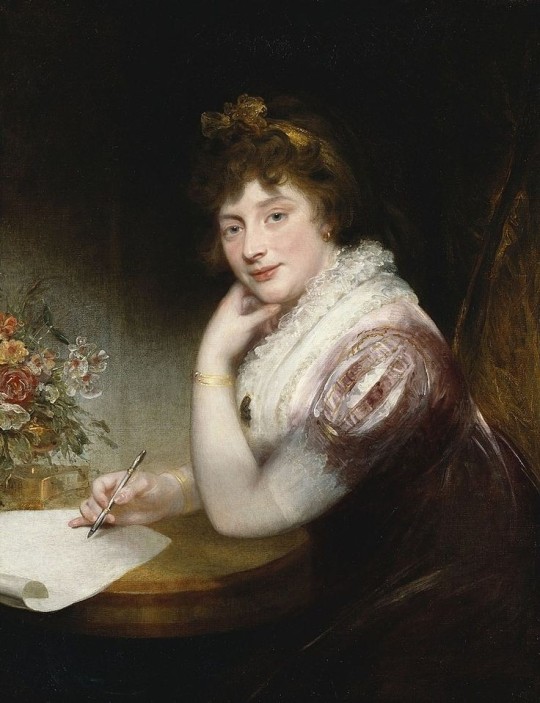



Daughters of Queen Charlotte and George III:
Charlotte, Princess Royal, Queen of Württemberg (1766-1828) Portrait by Sir William Beechey
Princess Augusta Sophia of the United Kingdom (1768-1840).Portrait by William Beechey
Princess Elizabeth of the United Kingdom,Landgrave of Hesse-Homburg, (1770-1840).Portrait by Sir William Beechey, 1797
Princess Mary, Duchess of Gloucester and Edinburgh (1776-1857). Portrait by Thomas Lawrence, 1824.
Princess Sophia of the United Kingdom (1777-1848). Portrait by Sir Thomas Lawrence, c. 1825
Princess Amelia of the United Kingdom (1783-1810). Portrait by Sir William Beechey
#queen charlotte#george iii#queen charlotte daughters#charlotte princess royal#princess augusta#princess elizabeth#pricess mary#princess sophia#princess amelia#qc:abs
4 notes
·
View notes
Text

Título completo: El maizal
Artista: John Constable
Fechas de artistas: 1776 - 1837
Fecha de realización: 1826
Medio y soporte: Óleo sobre lienzo
Dimensiones: 143 × 122 cm
Resumen de inscripción: Firmado; Con fecha de
crédito de adquisición: Presentado por suscriptores, incluidos Wordsworth, Faraday y Sir William Beechey, 1837
Numero de inventario: NG130
Un niño ha hecho una pausa del sediento trabajo de pastorear ovejas al mediodía para acostarse en la orilla de un estanque y beber su agua fresca. Esta visión de un carril de Suffolk en pleno verano se pintó entre enero y marzo de 1826 en el estudio de Constable en Londres. El camino que serpentea hacia el campo de maíz se basa en Fen Lane, por el que Constable había caminado a menudo cuando era niño desde su propio pueblo de East Bergholt hasta Dedham, donde asistió a la escuela. El carril todavía existe, pero el campo que se muestra más allá fue inventado en gran parte.
Constable exhibió la pintura en la Royal Academy en 1826. A pesar de recibir elogios de la crítica, no se vendió, ni en la Royal Academy ni en ninguna de las otras cuatro exposiciones a las que Constable la envió. Un comité de amigos y admiradores finalmente compró The Cornfield y lo presentó a la National Gallery en 1837 como tributo a Constable después de su muerte.
Información e imagen de la web de la National Gallery de Londres.
2 notes
·
View notes
